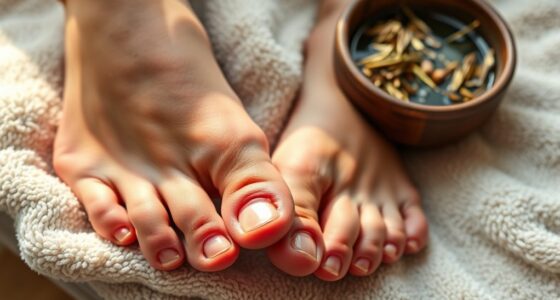When your dog gets wet, bacteria and yeasts that live on their skin find ideal conditions to grow—moisture, warmth, and oils. These microbes break down skin oils and dead cells, releasing foul odors as they thrive. Dirt and debris trapped in fur can make smells worse. Proper drying and hygiene can help, but if you’re curious about how to keep that wet dog smell at bay, there’s more worth exploring.
Key Takeaways
- Wet dog smell results from bacteria and yeasts thriving on moist skin and fur, producing foul-smelling compounds.
- Moisture retention in fur after bathing or swimming promotes bacterial and fungal growth, causing odor.
- Thick, dense coats trap more water and oils, prolonging dampness and increasing scent.
- Natural skin oils mixed with water and microbes intensify odors when the coat is wet.
- Poor drying, hygiene, and environmental humidity create ideal conditions for odor-causing microorganisms to flourish.
The Science Behind Wet Dog Odor

When a dog gets wet, the familiar odor you notice isn’t just caused by water but results from a combination of factors. As your dog’s fur absorbs moisture, it creates an environment ideal for bacteria and yeasts to thrive. These microorganisms produce smelly compounds as they break down oils and dead skin cells on your dog’s skin. Additionally, the water itself can dissolve natural oils in your dog’s coat, releasing their scent into the air. The more your dog’s fur retains moisture, the stronger these odors become. This process is natural but can be intensified by the presence of certain bacteria and yeasts that flourish in damp environments. Understanding this science can help you better manage your dog’s post-bath aroma. Regular grooming and drying can prevent moisture buildup and reduce odor.
Bacteria and Yeasts on Your Dog’s Skin

When your dog gets wet, bacteria and yeasts on their skin can multiply rapidly. Factors like skin moisture and natural oils create the perfect environment for overgrowth. Understanding how these microbes thrive helps you better manage your dog’s wet dog smell. Regular bathing with appropriate products can help reduce indoor air pollutants that contribute to lingering odors.
Skin Bacteria Growth
Skin bacteria and yeasts naturally live on your dog’s skin, but if their growth gets out of control, it can lead to that familiar wet dog smell. When bacteria multiply rapidly, they produce foul odors as they break down oils and dead skin cells. Excess moisture from bathing, sweating, or humid weather creates an ideal environment for bacteria to thrive. Poor hygiene or skin issues can also allow bacteria to overgrow. As bacteria multiply, they release compounds that give off that characteristic damp, musty odor. You might notice the smell intensifies after your dog gets wet or has been lying in damp areas. Maintaining good hygiene, keeping your dog dry, and addressing skin health can help control bacterial growth and reduce that unpleasant smell. Skin health is essential in preventing overgrowth of bacteria and yeasts on your dog’s skin.
Yeast Overgrowth Factors
Yeast overgrowth on your dog’s skin can occur when environmental conditions and health factors create an ideal breeding ground. Warmth, darkness, and moisture foster yeast proliferation, especially if your dog has a compromised immune system or skin issues. Poor hygiene, excessive bathing with harsh shampoos, or allergies can disrupt the skin’s natural balance, allowing yeasts and bacteria to multiply rapidly. Certain breeds are more prone to yeast overgrowth due to skin folds or hair type that traps debris and warmth. An imbalance in the skin’s pH level also encourages yeast growth. Skin health plays a critical role in preventing yeast overgrowth, as healthy skin resists microbial imbalance. When yeast overgrows, it produces foul odors, greasy skin, and irritation. Keeping your dog’s skin clean and healthy helps prevent yeast from taking hold and minimizes that distinctive wet dog smell.
Moisture’s Role
Moisture plays a key role in how bacteria and yeasts thrive on your dog’s skin. When your dog gets wet, water creates an ideal environment for these microorganisms to multiply. Damp fur and skin provide the perfect conditions for bacteria to flourish, leading to increased odor. Yeasts also thrive in moist environments, contributing to that characteristic wet dog smell. If your dog doesn’t dry properly after swimming or walks in the rain, bacteria and yeasts can quickly overgrow. This overgrowth intensifies the smell and can cause skin irritation. Keeping your dog dry and well-ventilated helps prevent this microbial buildup. Regular baths with thorough drying, especially in humid weather, are essential to reduce moisture and keep bacteria and yeasts from taking over your dog’s skin. Using deep cleaners can help eliminate bacterial and yeast buildup more effectively.
The Role of Natural Skin Oils
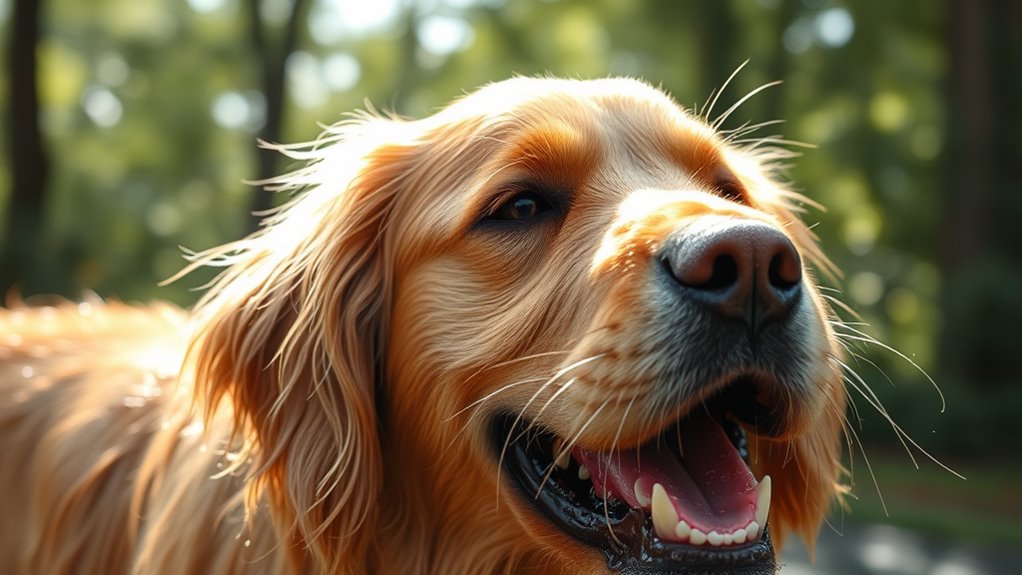
Natural skin oils play a essential role in how your dog’s coat smells. These oils, produced by glands in your dog’s skin, help keep the coat healthy and shiny. They also create a natural barrier that protects against dirt, bacteria, and moisture. When your dog’s coat is dry, these oils sit on the surface, giving a subtle scent that’s part of their natural aroma. However, when your dog gets wet, these oils can mix with water and microorganisms, intensifying odors. Over time, excess oils can trap dirt and bacteria, which contribute to the wet dog smell. Maintaining a balanced coat with regular grooming helps regulate oil levels, reducing the intensity of odors when your dog gets wet. Proper grooming techniques can help manage excess oils and minimize odors effectively.
How Water Activates Odor-Producing Microorganisms
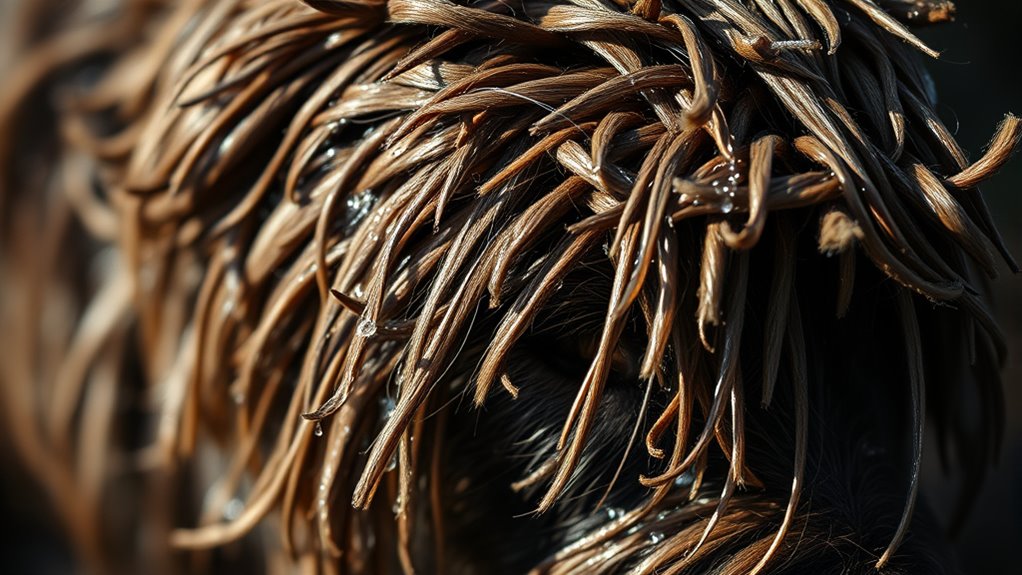
When your dog gets wet, the water interacts directly with the natural oils on their skin and coat. This creates a moist environment ideal for microorganisms like bacteria and yeast to thrive. These tiny organisms feed on oils, dead skin cells, and organic matter, producing waste that releases the familiar wet dog odor. Water helps these microbes multiply faster by providing the humidity they need to grow and reproduce. As they break down oils, they release volatile compounds responsible for the strong, often pungent smell. The more your dog stays wet, the more these microorganisms flourish, intensifying the odor. Additionally, Kia Tuning options such as performance exhaust systems can influence a vehicle’s smell during operation, illustrating how different environments and modifications can impact odor production. That’s why even a quick dry can considerably reduce the smell, as it limits microbial activity and slows down their production of odor-causing substances.
The Impact of Dirt and Debris
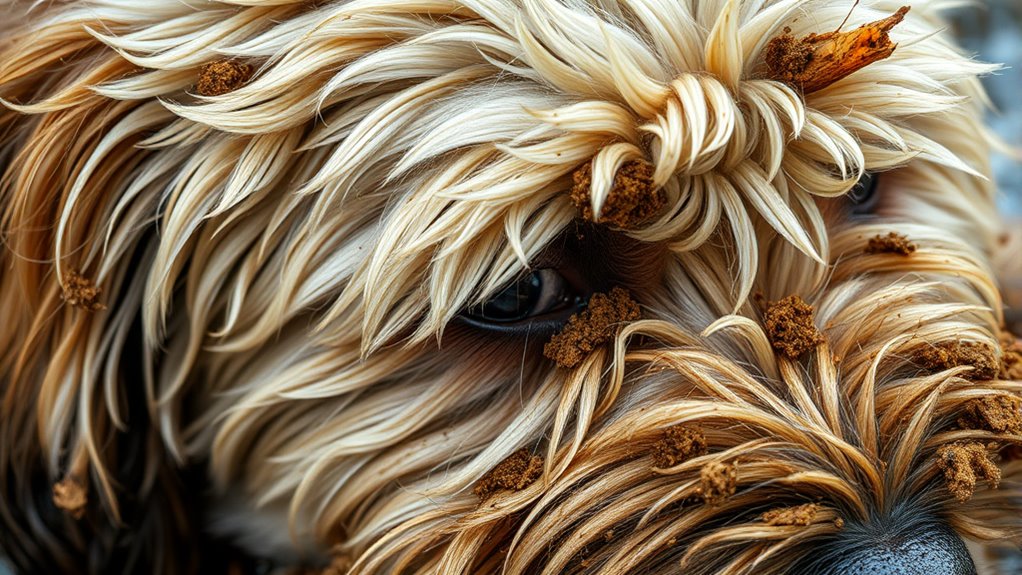
Dirt and debris on your dog’s coat can considerably contribute to the wet dog smell. When your dog gets wet, these particles cling to their fur, trapping moisture and creating an environment for bacteria and fungi to thrive. This combination intensifies the odor, making your dog smell even more pungent after a bath. The more dirt your dog accumulates, the stronger the smell becomes when wet. Regular grooming and cleaning help minimize this issue. Removing dirt and debris before bathing prevents odors from intensifying and keeps your dog smelling fresher longer. Staying on top of your dog’s hygiene reduces the chances of stubborn smells lingering after a bath. Additionally, understanding that antioxidants in your dog’s diet can support overall skin health and reduce odor-causing bacteria may contribute to a fresher scent.
Differences in Breed and Coat Type
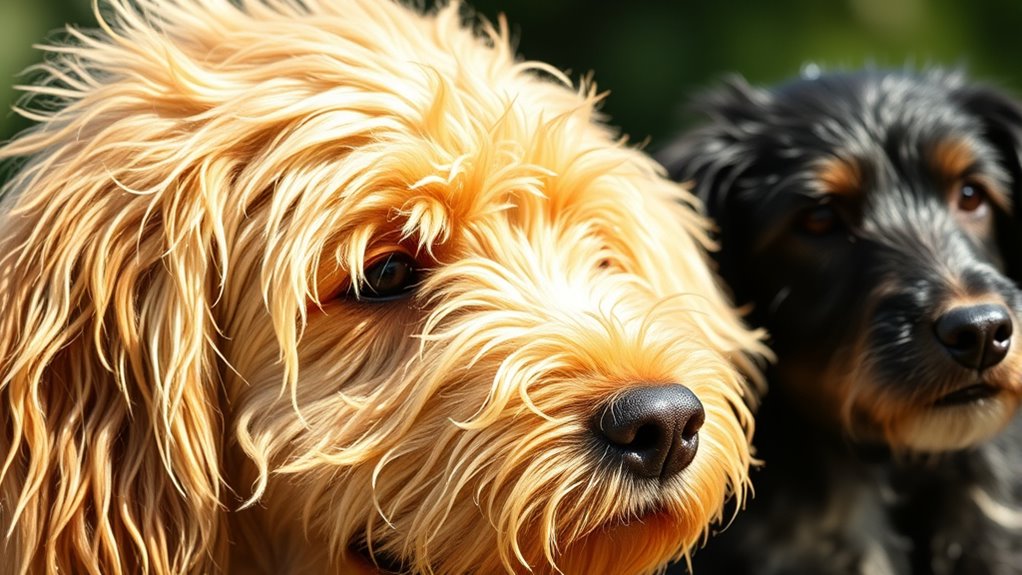
You’ll notice that some breeds have denser coats that trap more moisture and odor, while others have lighter fur that dries quickly. The natural odor traits vary, with certain breeds producing stronger smells when wet. Additionally, hair texture—whether straight, wavy, or curly—affects how wetness and smells linger after a bath. Understanding home theatre projectors can also help you choose the right environment for your pet to minimize lingering odors.
Coat Density Variations
Different dog breeds and coat types vary markedly in their density, which directly influences how much they retain moisture and odor. Thick, double coats trap more water after a bath or swim, prolonging dampness and the wet dog smell. Conversely, dogs with short, fine coats dry faster and usually smell less when wet. The density also affects how bacteria and yeast thrive on the skin, impacting odor levels. Breed and coat type play crucial roles in odor persistence, as some breeds are more prone to retaining moisture than others. To understand this better, consider: – Dense coats hold more water, increasing odor persistence. – Single-layer coats tend to dry quicker, reducing smell duration. – Hair length and thickness influence how long your dog stays damp and smelly after getting wet.
Breed Odor Traits
Breed and coat types substantially influence a dog’s natural odor, with some breeds inherently emitting more scent than others. For example, hounds and scent-based breeds often produce stronger odors due to their heightened gland activity. Breeds with oily or water-resistant coats, like retrievers or spaniels, tend to trap more oils and dirt, intensifying their smell when wet. Conversely, breeds with short, smooth coats, such as boxers or Dalmatians, usually have milder odors. Your dog’s genetic makeup determines the amount and type of skin oils produced, affecting how much scent is released. Some breeds are naturally more prone to oil buildup, making them smellier, especially after swimming or bathing. Understanding your dog’s breed traits helps you anticipate and manage their unique odor profile effectively.
Hair Texture Differences
The texture of a dog’s hair plays a significant role in how odors develop and linger. Dogs with different coat types retain moisture and odor-causing bacteria differently. For example, dogs with wiry or curly hair often trap more dirt and moisture, leading to stronger wet dog smells. Conversely, smooth-coated breeds dry faster and tend to smell less after getting wet. Long-haired dogs may hold onto wetness longer, intensifying odor, while short-haired breeds air out quickly. Understanding your dog’s coat can help you manage wet smell better.
- Curly or wiry coats trap more moisture and dirt.
- Short coats dry faster and smell less.
- Long hair retains water, prolonging odor.
Environmental Factors Contributing to Smell

Environmental factors such as humidity, temperature, and dirt accumulation play a significant role in intensifying the wet dog smell. High humidity creates a damp environment that encourages bacterial growth on your dog’s coat, making odors stronger. Warm temperatures speed up the bacteria’s activity, increasing the scent’s intensity. If your dog spends a lot of time outdoors in muddy or dirty areas, dirt and organic matter cling to their fur, trapping odors and making them more noticeable when wet. Additionally, stagnant air can trap smells close to your dog’s skin, amplifying the scent. By controlling these environmental factors—keeping your dog dry, cool, and clean—you can help reduce the strength and duration of the wet dog smell.
Why Some Dogs Smell More Than Others

Some dogs naturally produce stronger odors than others, even under similar environmental conditions. This variation depends on factors like breed, skin type, and health. Certain breeds, such as Basset Hounds or Beagles, have oilier skin or more active scent glands, making them smellier. Additionally, dogs with thicker coats trap more oils and dirt, increasing odor intensity. Skin conditions, allergies, or infections can also amplify smells in some dogs. Regular grooming helps, but genetic makeup and individual biology play significant roles in odor levels. Recognizing these differences helps you manage your dog’s smell better and tailor grooming routines accordingly.
Some dogs naturally have stronger odors due to breed, skin type, and health factors.
- Breed and coat type influence natural odor levels
- Skin health and underlying conditions impact smell
- Grooming frequency can reduce or enhance odors
The Effect of Drying Methods on Odor
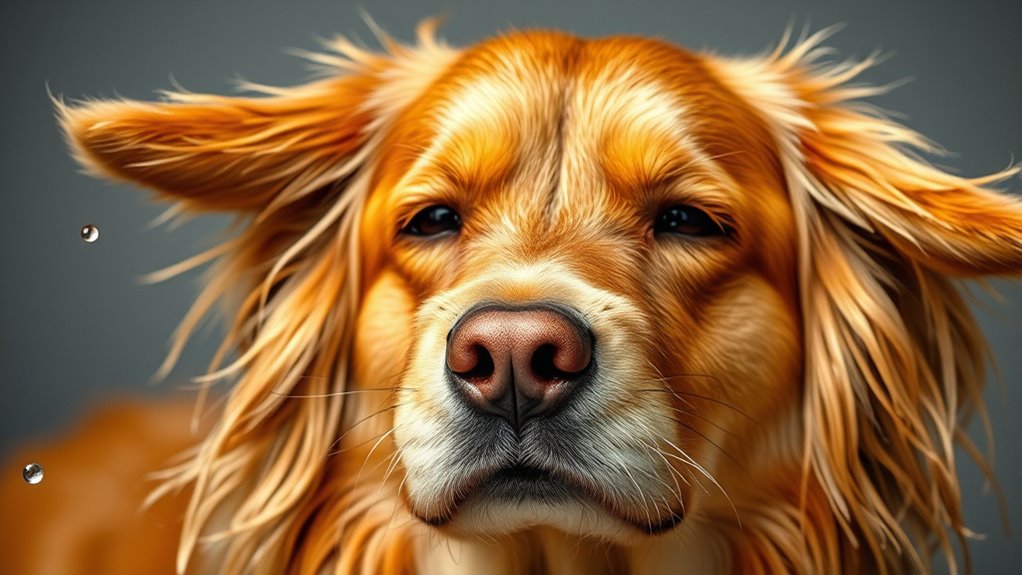
Choosing how to dry your dog can influence their lingering smell. Air drying is gentle but may leave moisture that causes odor, while toweling can sometimes leave residue that traps odors. Using a blow dryer speeds up drying but risks irritating your dog’s skin and intensifying odors if not done carefully.
Air Drying Effectiveness
Air drying is often considered a simple and natural way to eliminate wet dog odor, but its effectiveness depends on how thoroughly and quickly your dog’s coat dries. If the coat dries unevenly or slowly, bacteria and mold can thrive, intensifying the smell. To maximize odor reduction, ensure your dog is in a warm, well-ventilated space. Keep brushing to help air circulate through the fur and remove excess moisture. Remember, patience matters—rushing the process can leave damp spots that contribute to odors. Properly air drying can be effective, but it’s less reliable if your dog has a thick or long coat. In such cases, supplementing air drying with other drying methods may help achieve better odor control.
- Proper ventilation speeds up drying and reduces odor buildup
- Regular brushing promotes even drying and odor removal
- Thick or long coats may require additional drying aids
Toweling Residue Impact
While air drying can be effective, the way you towel dry your dog also impacts odor control. If you rub vigorously or use a dirty towel, you can leave behind residue like dirt, oils, and dead skin cells, which promote bacteria growth and worsen the wet dog smell. Using a clean, absorbent towel and gently patting your dog dry helps remove excess moisture without embedding debris into the fur. Additionally, some towels contain chemical treatments or fragrances that could trap odors or cause skin irritation, making the smell worse. Proper towel drying minimizes residual moisture and prevents bacteria buildup, reducing the chances of odor lingering. Remember, the goal is to dry thoroughly without causing skin irritation or trapping unwanted residues that can contribute to that familiar wet dog smell.
Blow Dryer Risks
Using a blow dryer to dry your dog can be quick and effective, but if not used carefully, it may actually worsen the wet dog smell. High heat or prolonged drying can cause the fur to trap moisture or spread bacteria, intensifying odors. Additionally, blowing air directly into the coat might loosen bacteria and dirt, pushing them deeper into the fur or skin. Overheating can also irritate your dog’s skin, leading to increased oil production that fuels odor. To reduce risks, keep the dryer on a low heat setting, avoid direct contact with the skin, and don’t over-dry.
- Use a cool or warm setting to prevent skin irritation
- Keep the dryer moving to avoid concentrated heat
- Dry thoroughly but gently to minimize bacteria buildup
Tips to Minimize Wet Dog Smell

To effectively minimize wet dog smell, it’s essential to dry your dog thoroughly after baths or walks in the rain. Use a high-quality towel to gently blot away excess moisture, paying attention to skin folds and ears. Follow up with a blow dryer on a low heat setting, keeping it at a safe distance to prevent burns. Brushing your dog’s coat regularly helps distribute natural oils, reducing odor buildup. Consider using a dog-specific deodorizing spray or rinse to neutralize smells. Keep your dog’s bedding and toys clean, as they can harbor lingering odors. Ensuring proper drying and hygiene routines helps prevent bacteria growth that causes the wet dog smell, so your furry friend stays fresh and odor-free longer.
Frequently Asked Questions
Can Certain Dog Diets Influence Wet Dog Smell?
Certain dog diets can definitely influence the wet dog smell. If your dog’s food contains lots of fillers or low-quality ingredients, it may cause stronger body odor and a more pungent smell when wet. On the other hand, high-quality, balanced diets with proper fats and proteins can reduce this odor. Make sure to feed your dog a nutritious diet and keep them well-hydrated to help minimize that wet dog smell.
Do Indoor Versus Outdoor Dogs Have Different Odor Levels?
Indoor dogs often have a stronger odor than outdoor dogs because they stay in confined spaces, which traps smells and bacteria. You might notice a wet dog smell more indoors because moisture and limited ventilation can intensify odors. Outdoor dogs tend to stay cleaner and dry, reducing odor levels. Regular bathing, proper hygiene, and good ventilation can help you manage and reduce your dog’s indoor scent.
How Does Humidity Affect Wet Dog Odor?
Humidity plays a big role in wet dog smell. When the air is humid, the moisture clings to your dog’s coat longer, allowing bacteria and yeast to thrive. This creates that strong, musty odor you’re familiar with. You might notice the smell worsens on humid days or after your dog gets wet. To reduce this, dry your dog thoroughly and ensure good ventilation, helping the smell dissipate faster.
Are There Specific Grooming Products That Reduce Wet Smell?
You can reduce wet dog smell by choosing grooming products designed for odor control, like deodorizing shampoos and sprays. These products contain ingredients that neutralize odors and keep your dog smelling fresh longer. Look for ones with natural deodorizers like citrus or tea tree oil. Regular baths, combined with good grooming routines, help prevent the buildup of bacteria and fungi that cause strong wet dog smells, keeping your pet’s coat clean and odor-free.
Does Age Impact the Strength of Wet Dog Odor?
Your dog’s age can impact the strength of wet dog odor. Older dogs might produce a stronger smell because their skin and coat change over time, sometimes trapping more bacteria or oils. As your dog ages, their grooming needs may increase, and regular baths with suitable products can help manage odor. Keep an eye on their health, too, since underlying issues can contribute to stronger smells when wet.
Conclusion
Understanding why wet dog smell occurs helps you manage it better. Remember, bacteria and yeasts on your dog’s skin produce odor when activated by water, and dirt or environmental factors can make it worse. Did you know that dogs with oily skin tend to smell more when wet? Proper drying techniques and regular grooming can markedly reduce odors, keeping your furry friend fresh and comfortable. With the right care, you can enjoy cuddles without the unwanted wet dog smell.




